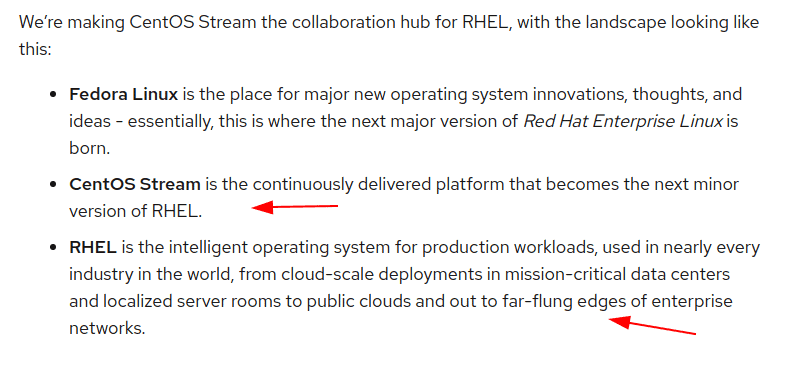
You are probably aware of the way Red Hat decided to discontinue CentOS 8 and replace it with rolling release CentOS.
This created a sort of rebellion among the CentOS users who rightly saw it as betrayal and a ‘dick move’ by Red Hat to force them to buy RHEL license.
CentOS was not adding value to Red Hat
After the massive backlash, Red Hat tried to defend the decision and its developers started saying that the ‘message could have been conveyed in a better way’.
However, only a few days later, Red Hat’s vice-president of Linux Engineering revealed the real reason everyone was already aware of: CentOS was not actually providing usefulness to Red Hat.
I would say the big one for us was that CentOS itself was not actually providing that much usefulness to Red Hat. Most of the communities we set up, Fedora for example, do have a lot of bidirectional community involvement. Unfortunately, CentOS was never like that. It was always a community of users, so that that contribution model was mostly one way.
Mike McGrath, Red Hat’s VP of Linux Engineering
So, between “the message could have been conveyed better” to “CentOS was not actually providing usefulness to Red Hat”, one thing was clear. Existing CentOS users were already looking for CentOS alternative distributions.
Red Hat saw the possible exodus of CentOS users and hence it tries to placate the angry users with free RHEL subscription.
No-cost RHEL program to provide free RHEL subscriptions for up to 16 servers
Red Hat sensed that people were worried about having to pay for Red Hat license or migrate their servers to some other distributions.
And hence they come up with the plan to allow them to use RHEL for free, as long as they don’t have more than 16 servers. The plan should be available before 1st February 2021.
Keep in mind that the ‘no-cost RHEL’ programs comes without Red Hat support (for technical issues). You can use Red Hat, that’s it. If you want support, you’ll have to upgrade (pay money).
What about intermediate to large-scale clients using more than 16 servers?
The move was always aimed at medium scale businesses using CentOS for free. They are the ones that can afford to pay for Red Hat subscription. Small businesses with a few servers could migrate easily to one of the CentOS alternatives. Migrating 20, 50 or 100s of servers would be a much bigger issue and paying to Red Hat would be better for some in such cases.
CentOS Stream is not advertised as capable of production workload
Look at this section from the official Red Hat announcement.

It portrays that RHEL is the ideal choice for production workload. For CentOS Stream, it says no such thing despite their developers claiming on social media that CentOS Stream is not a beta product, not rolling release and stable enough to run production servers.
Somehow that confidence in CentOS Stream evaporated in the official announcement? Or perhaps the real reason is to pitch Red Hat as their recommendation for production servers. You decide.
The olive branch offered by Red Hat may make some small-scale users happy. It doesn’t wash off the corporate greed painted all over them. What do you think?
- Even the biggest players in the Linux world don't care about desktop Linux users. We do.
- We don't put informational content behind paywall. Your support keeps it open for everyone. Think of it like 'pay it forward'.
- Don't like ads? With the Plus membership, you get an ad-free reading experience.
- When millions of AI-generated content is being published daily, you read and learn from real human Linux users.
- It costs just $2 a month, less than the cost of your favorite burger.
Become a Plus Member today and join over 300 people in supporting our work.

![In a Move to Retain Small-Scale CentOS Users, Red Hat Allows Free RHEL Download [With Ifs and Buts]](/content/images/size/w30/wordpress/2021/01/RHEL-No-Cost-Plans.png)







